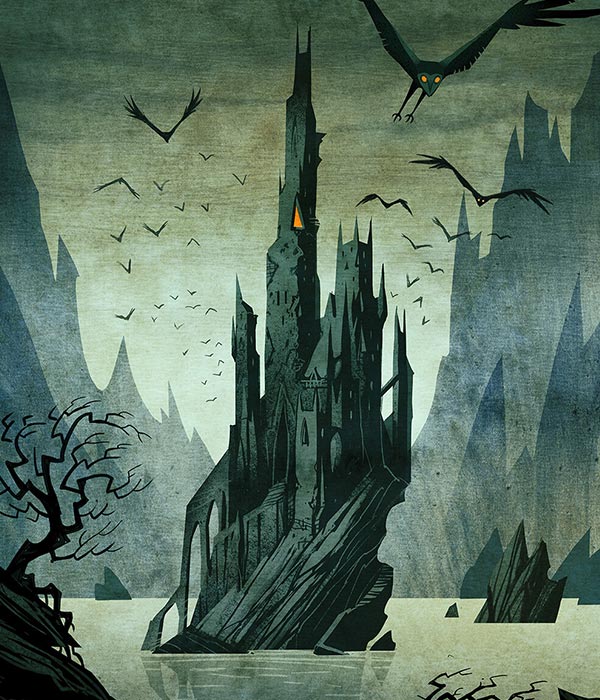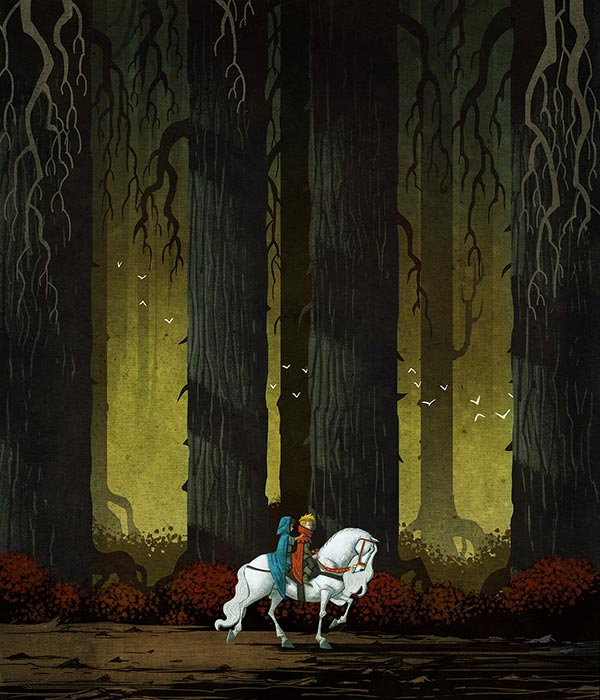Subtotal: $
Checkout
Avid readers of Tolkien will recognize the word eucatastrophe – the term the great fantasy author coined in his essay “On Fairy-Stories” to describe the sudden turn towards joy and salvation at a point in the plot when all seems lost. It’s the eagles over the horizon, the echoing crack of the Stone Table, the moment in the myth when something of the power of Easter morning resounds in the realm of fantasy.
Astrid Lindgren, the beloved Swedish children’s author of the twentieth century, is best known in America for Pippi Longstocking, her redhaired, pigtailed girl with superhuman strength and a boundless joy for child-centered anarchy. But it’s her fairy tale, Mio, My Son, that leverages the power of eucatastrophe so masterfully, and is so shot through with Christian themes, that makes the story of a Swedish foster child whisked away to a magical kingdom one of the greatest stories of hope, loss, and restoration in modern children’s literature.
Our greatest stories reveal another side to our perennial questions of death, loss, and longing: Salvation. Reunion. Hope.
Mio, My Son, was published in 1954, the same year as The Fellowship of the Ring. Lindgren wrote it while mourning her husband’s death, and immediately we are taken into the sad, gray world of young Karl Anders – Andy – Nilsson. The child is unloved by his foster parents and nearly friendless, save a decrepit cart horse and one boy in his Stockholm neighborhood, whose relationship with his father burns Andy with a pain of longing.
When he discovers a genie in a bottle, Andy’s longing cries out, a heartache even deeper than loneliness, which knows that somewhere, there is a promise of something – and someone – better.
Then I gathered my courage and asked, “Genie, where do you come from?”
He was silent a moment. Then he said, “I come from Farawayland.”
He said it so loudly that it rang and thundered in my head, and something in his voice made me long for that place. I felt as if I could not live if I didn’t get to go there. I raised my arms up toward the genie and shouted, “Take me with you! Oh, take me to Farawayland! Someone is waiting for me there.”
Lindgren narrates the tale with simple, repetitive language. We learn that Andy’s real name is Mio, and his father – alive, and searching all this time for his son – is the king of Farawayland. Like a very young child who needs to impress this astonishing fact in his mind over and over again, Lindgren, in Mio’s voice, always refers to the unnamed king as “my father the King,” and the king in turn always tenderly calls him “Mio, my son” – this relationship, we’re reminded on every page with these names, is the crux upon which the whole adventure turns.
The story works with elemental words and images – darkness, water, light, fear – that convey something more like a primal fairy tale than Tolkien’s grandiose worldbuilding (though there are aspects like a wayfarer’s Bread that Satisfies Hunger or the hero’s small, faithful friend that will be familiar to Lord of the Rings readers). The dreamlike quality of Lindgren’s language – descriptions of a well that whispers ancient stories, a forest bathed in moonlight, an old weaver who works in sorrow – is reminiscent of George MacDonald’s The Princess and the Goblin or The Golden Key, and part of Mio’s quest takes him deep underground, on a journey of repeatedly tested faith that reminded my children of C. S. Lewis’s The Silver Chair.

Artwork by Johan Egerkrans
That quest begins shortly after arriving in Farawayland, when Mio discovers an evil that casts a shadow of fear and sorrow even over the most idyllic settings of his new home. When a new friend’s grandmother prepares them for a wonder-filled night under the stars, she realizes the boys are underdressed.
“When the dew begins to fall you’ll be cold.” She suddenly looked very sad. “I have two more cloaks,” she said in a quiet little voice.
She went over to an old chest which was standing in a corner of the cottage and took out two cloaks, a red one and a blue.
“My brothers’ cloaks,” said Nonno, looking so sad, too.
“Where are your brothers?” I asked.
“Sir Kato,” whispered Nonno. “The cruel Sir Kato seized them.”
The presence that threatens Mio’s paradise is one of the most ancient, terrifying evils in the history of storytelling: one that steals children. And it’s here that I find the Christian elements of Mio’s quest – despite Lindgren’s fairly agnostic beliefs as an adult – so compelling. Whether in Stockholm or Farawayland, Middle Earth or the Shadowlands, we grapple with this truth: that we will lose the ones we love. It’s the sorrow of young Jack Lewis grieving for his mother, or Digory Kirke’s quest for a healing fruit to cure his own – our shared vale of tears. And so our stories ask: Is this end inevitable? Can we put Death to death?
Astrid Lindgren answers with a harrowing of hell, led by a small child.
Mio undergoes a moonlit agony of realization that this is his burden, as he talks to his faithful companion, Pompoo (yes, parents, you’re just going to have to steel yourselves for reading aloud to your children about a character named Pompoo).
“Your father the King has always known it,” said Pompoo.
“Does he want me to go?” I asked, and I couldn’t help the little quaver in my voice.
“Yes, he wants it,” said Pompoo. “He mourns, but he wants you to go.”
“Yes, but I’m so scared,” I said and I began to cry. Now, for the first time, I realized just how scared I was. I took Pompoo’s arm.
“Pompoo, I can’t,” I said. “Why does my father the King want me to do it?”
“A boy of royal blood is the only person who can,” said Pompoo. “Only a boy of royal blood can do it.”
“But what if I die?” I said, gripping Pompoo’s arm.
He didn’t answer.
“Does my father the King want me to go, no matter what happens?”
…Not a sound was heard. Silence was everywhere.
Pompoo nodded.
“Yes,” he said, faintly so that I scarcely heard it. “Your father the King wants you to go, no matter what happens.”
During our recent reread of Mio, my six-year-old son grew very concerned at this point.
“I’m scared Sir Kato will be there! And he will be real!”
“Do you think Mio will go?” I asked.
A quick, if not resigned, answer – “Yes.”
“Why will he go?”
“Because he wants to obey his dad, the king.”
“Why would he want to do that? It sounds like such a scary thing.”
He grew quiet for a second, his usual puckishness stilled as he considered the question.
“Because,” he thought out loud, “he thinks he’s the greatest person in the world.”
Through very simple language, Astrid Lindgren convinced a kindergartener of the depth of love that moves us to self-sacrifice and courage – a loyalty beyond blind obedience, intertwined with childlike trust in the Father’s goodness. It’s the love that underpins the saints’ heroic virtue, or, to my son, that moves a scared boy to mount his flying horse and fulfill a prophecy. There is no eucatastrophe without it, no matter how insignificant our role.

Artwork by Johan Egerkrans
I won’t give away how Mio’s plunge into the heart of Sir Kato’s fortress unfolds, save that it belongs in the great family of literature that hopes – and offers that hope to children – that somehow, the world we’ve lost will be made new.
We shiver with joy when Lucy and Tumnus meet again and dance in the ruins of the White Witch’s castle. And I feel a catch in my voice as I pull my children close during the final chapters of Mio, My Son, these children who do not belong to me, whose journeys are entirely distinct from my own, but whom I dare hope to find again. Because as Tolkien knew, our greatest stories reveal another side to our perennial questions of death, loss, and longing: Salvation. Reunion. Hope. We believe in God’s death-destroying act of eucatastrophe – Christ’s banner of victory charging through hell, carried out of love for his father and the lost children he leads by the arm out of darkness.
Mio, the sad little boy from Stockholm, is the son of his father, the King. And because of that magical, life-altering fact, this gray world of loss and loneliness is not his end.
Elizabeth Hansen’s writing has appeared in Magnificat, Columbia Magazine, FemCatholic.com, and other publications. She and her husband read out loud to their four children in Lansing, Michigan.
Already a subscriber? Sign in
Try 3 months of unlimited access. Start your FREE TRIAL today. Cancel anytime.






Naomi Johnson
My curiousity was aroused due to this review and I ordered a used copy of Mio My Son which I started reading last night. Thanks not only for the heads up, but as a student of writing I also appreciate the excellent review style and content of this piece. I'm taking notes!
Leslie Gross
With a description of such a lovely book, it would be great for you to tell us where to find it. Great books for children are sometimes hard to find.
Sally Gerard Gates
What a powerful telling of this story. I'm right there with you when you read to your children. Thank you for the reminder of the hope that is to come.